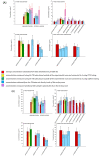Development of a Long-Term Sampling Method for Determination of NMHCs in Indoor Air
- PMID: 37446664
- PMCID: PMC10343520
- DOI: 10.3390/molecules28135001
Development of a Long-Term Sampling Method for Determination of NMHCs in Indoor Air
Abstract
Vapor intrusion is detrimental for indoor air quality. One of the most common sources of vapor intrusion is soil contaminated with petroleum hydrocarbons. To evaluate the long-term risk from individual exposure to hydrocarbons it is necessary to measure quantitively and reliably an average concentration level of individual pollutants on a monthly or yearly basis. Temporal variability of vapor intrusion from hydrocarbons poses a significant challenge to determination of average exposure and there is a need for reliable long-term integrative sampling. To this end, an analytical method for determination of 10 selected nonmethane hydrocarbons (NMHCs), including hexane, heptane, octane, decane, benzene, toluene, ethyl-benzene, m,p-xylene, o-xylene, and naphthalene, sampled on active triple-bed tubes filled with Carbograph 2, Carbograph 1, and Carboxen 1003 adsorbents was developed and validated. Extensive laboratory studies proved the absence of breakthrough at 50% HR and ambient temperature for experiments lasting up to 28 days and established a safe sampling time/volume of 20 days/114 L when sampling at a low flow rate of around 4 mL min-1. In addition, the developed method includes detailed uncertainty calculations for determination of concentrations. Finally, the method was tested by measuring NMHC concentrations in indoor air at a former industrial site during a 2-month-long field campaign in Lyon. The results of the field campaign suggest that 4-week integrated concentration measurements can be achieved by using active sampling on triple-bed tubes at 4.5 mL min-1.
Keywords: breakthrough studies; gas sampling; indoor air; method development; method validation; non-methane hydrocarbons (NMHCs); uncertainty calculations; vapor intrusion.
Conflict of interest statement
The authors declare no conflict of interest.
Figures








Similar articles
-
Exposure assessment modeling for volatiles--towards an Australian indoor vapor intrusion model.J Toxicol Environ Health A. 2007 Oct;70(19):1619-34. doi: 10.1080/15287390701434711. J Toxicol Environ Health A. 2007. PMID: 17763080
-
Personal and ambient exposures to air toxics in Camden, New Jersey.Res Rep Health Eff Inst. 2011 Aug;(160):3-127; discussion 129-51. Res Rep Health Eff Inst. 2011. PMID: 22097188
-
Evaluation of offline sampling for atmospheric C3-C11 non-methane hydrocarbons.J Environ Sci (China). 2022 Mar;113:132-140. doi: 10.1016/j.jes.2021.05.022. Epub 2021 Jun 23. J Environ Sci (China). 2022. PMID: 34963523
-
Building science approaches for vapor intrusion studies.Rev Environ Health. 2019 Sep 25;34(3):245-250. doi: 10.1515/reveh-2019-0015. Rev Environ Health. 2019. PMID: 31494643 Free PMC article. Review.
-
Health Misinformation about Toxic-Site Harm: The Case for Independent-Party Testing to Confirm Safety.Int J Environ Res Public Health. 2021 Apr 7;18(8):3882. doi: 10.3390/ijerph18083882. Int J Environ Res Public Health. 2021. PMID: 33917146 Free PMC article. Review.
References
-
- ANSES Indoor Air Quality Guidelines (IAQGs) [(accessed on 15 November 2021)];2018 Available online: https://www.anses.fr/en/content/indoor-air-quality-guidelines-iaqgs.
-
- Strandberg B., Sunesson A.-L., Olsson K., Levin J.-O., Ljungqvist G., Sundgren M., Sällsten G., Barregard L. Evaluation of two types of diffusive samplers and adsorbents for measuring 1,3-butadiene and benzene in air. Atmos. Environ. 2005;39:4101–4110. doi: 10.1016/j.atmosenv.2005.03.039. - DOI
-
- US EPA Technical Guide for Assessing and Mitigating the Vapor Intrusion Pathway from Subsurface Vapor Sources to Indoor Air. [(accessed on 27 October 2022)];2015 Available online: https://www.epa.gov/vaporintrusion/technical-guide-assessing-and-mitigat....
MeSH terms
Substances
Grants and funding
LinkOut - more resources
Full Text Sources
Medical
Miscellaneous

